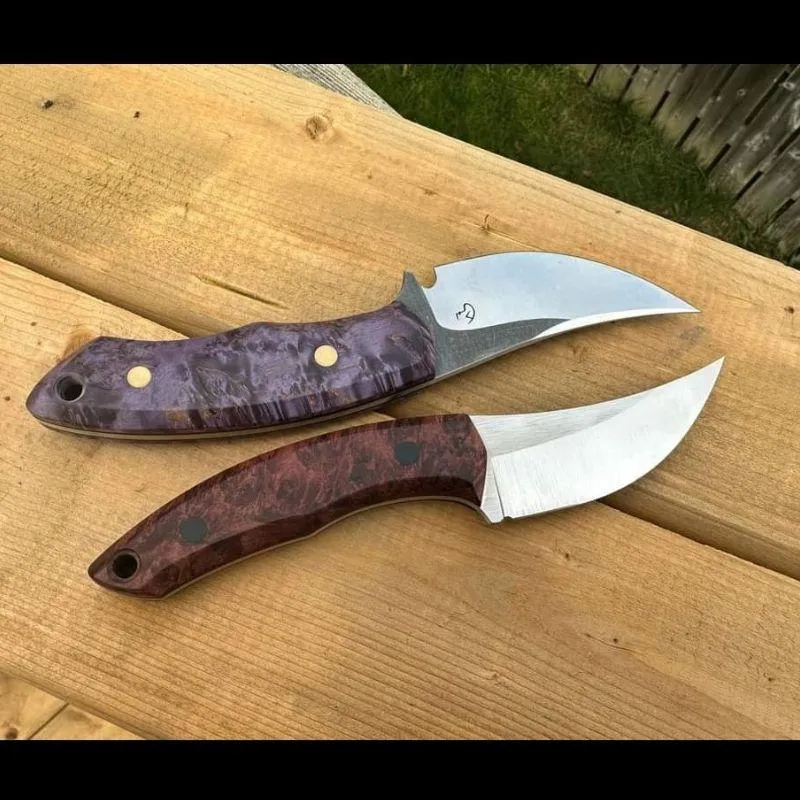Maintenance
The DO's
When you first receive your knife, it may have some oil on the blade which is used to protect the blade from any trapped moisture which could cause the knife to rust during shipping. You can wipe it down with a tissue or use some nail polish remover on a paper towel and the edge will be cleaned up and ready for work.
Knives with wooden handles are usually treated with a wax or oil before I send them out. Please give them at least 1 week to cure before letting excessive water get on the handle. A few drops won’t hurt but washing the knife thoroughly or using it in very wet conditions might interfere with the oil/wax curing process. After a week (I usually let it sit in the shop for a few days before shipping) the handle should be nice and water resistant!
When you first get your knife, it will ideally be very nice and sharp and ready for use. I sharpen my blades by hand on waterstones and try to give them the ideal edge for their intended use.
To maintain the edge and keep it nice and sharp, I would recommend investing in a strop and compound OR a ceramic honing rod. Or both. Both is good. You can always send them to me for a sharpening at your expense. Please check the blog for more information on the topic of edge maintenance.
When cleaning your knife, handwash with water or soap and dry it off with a towel. Be careful not to cut yourself! Once you’ve toweled off the water, give it some time for any moisture to air dry before putting it back in the sheath, 5-10 minutes should do.
I would recommend getting into the habit of washing and toweling off your knife after every use. Letting the knife sit overnight with food residue on the blade or half submerged in water in the sink can cause rusting or decoloration. I use AEBL stainless steel mostly but even much more stainless steels can oxidize, rust, or be discolored when neglected.
The DON'T's
Never put your knives in the dishwasher. The movement and jostling will quickly ruin the sharp edge of the blade and make it dull(er). The heat and heavy soak will almost definitely mess with any natural handle materials and cause deformation or swelling. The heat will also most likely ruin the epoxy bond that I use on my knives to hold the handle together. Once that happens, it's only a matter of time before the knife handle falls apart. Not good.
Regarding kitchen knives... they are usually ground very thin to make them cut exceptionally well. That also can make them a bit more brittle than an inexperienced user would expect. Don't use it to cut through anything hard. A good general rule is if you wouldn't bite into it with your teeth, don't cut it into it with your knife. Use a hatchet instead!
Never use a pull through sharpener on your blades. They are horrible. It should be a crime. Seriously don’t do it. I’ll take it personally.
Never put a wet knife into its sheath or an enclosed area. Trapped moisture will rust any steel, even the most stainless ones. Always wipe off your steel with a towel (paper towel, tissue, whatever you got) and then let it air dry for about 5-10 minutes first. Once I'm done cooking I usually wash my knife, wipe it down, and let it sit on the cutting board or a dry paper towel to air dry.
A magnetic knife block mounted on the wall or standing on the countertop is a great investment for high end kitchen knives.
For fixed blade knives you carry, wipe them down and let them air dry nearby. If they must be sheathed immediately, my kydex sheaths do typically have a weephole for moisture to get out but try to remember to remove the knife and let it air dry if possible.Never leave your knife anywhere it could overheat. You'll have to use your better judgement but the dashboard of a car on a hot summers day can definitely cause the epoxy to fail. And it did on a customers knife once.
Also keep in mind that extreme cold temperatures can also have a similar effect on your handles made of natural materials like wood or bone. It can cause rapid shrinking which can cause it to deform and maybe separate from the handle. A knife collector with quite a lot of experience with custom made knives told me that mammoth molar and ironwood handles both seem to crack once the weather gets to -30 Celsius. Canada, eh?
For blades that you intend to take to extreme climates, I recommend a knife with a synthetic handle material like G10, Richlite, micarta, etc.
Follow Our Instagram
Ready to Buy Your Knife?

